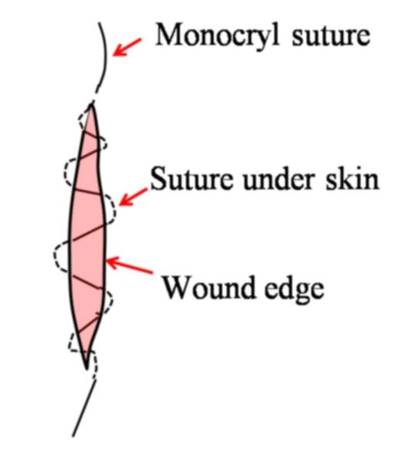The operation report will give specific instructions on how to look after your wound.
In general there are 3 types of sutures used to close your surgical wound.
1. Nylon sutures
- Small wounds eg trigger finger, Carpal tunnels should be kept dry for 2 - 3 days and then can be wet in the shower.
- This is an interrupted suture that can be seen from the outside and crosses the wound edges from side to side.
It can produce a scar with a criss /cross appearance rather than just a straight line.
- I use them particularly if early movement of the part is desirable. For example in the finger after a fracture.
- 50 Nylon is particularly used in fingers, on the palm and in Dupuytrens surgery.
The “50” refers to the gauge or size of the suture - Not fifty sutures!


2. Monocryl sutures
- 50 Monocryl subcuticular is a buried suture. It tends to leave a better scar which is a straight line scar. .
- Must be kept dry and leave dressings and steristrips intact for 10 days.
- Monocryl is a dissolving suture which can be left in-situ and will dissolve spontaneously over weeks to months.
- It is often combined with small white tapes called steristrips which are glued to the wound at the end of the operation with Op site spray. These must not be removed until at least the post operative visit.
- The ends of the Monocryl sutures are often tied over the steristrips to prevent the wound pulling apart.
- Even though Monocryl sutures can dissolve I often remove these sutures and leave the steristrips until they fall off.
- Removing the suture may improve the long-term appearance of the wound.
- The Monocryl suture can occasionally cause an allergic skin reaction in some people.
- In longer wounds I just cut the ends of the Monocryl sutures flush with the skin after cleaning with alcohol swabs.
- Monocryl is particularly used on the back of the hand and in the forearm.
- Must be kept dry and leave dressings and steristrips intact for 10 days.




3. Vicryl Rapide
Is a suture often used in children and has been used recently because of Covid 19.
The sutures DO NOT need to be removed.
The sutures will wash out in soapy water.
I do not use it routinely because the Vicryl can cause more tissue reaction than Nylon sutures.
For Wounds closed with Vicryl Rapide:
1. Leave the dressings for 7 - 10 days as directed in the operation report.
2. Keep the wound dry.
3. After 7 - 10 days remove the dressings and wash the wound.
4. Apply a Bandaid.
5. Wash the hand regularly with soapy water and the sutures will wash out.
6. If the sutures do not wash out they can be removed.
For more information on Wound Care.
Dressings and plasters
- Your hand will be dressed with a non stick dressing called Mepitel and then a pad of Velband then a crepe bandage following your surgery.
- This dressing should stay intact until your follow-up appointment unless indicated in the operation report.
- You will only need dressings for the first 10 days or so until primary healing has occurred.
- Depending on the type of surgery you may well have a plaster slab bandaged to the wrist or hand over the dressing.
- Often this is for comfort only and can be removed soon after the surgery to allow early movement.
- Just unwrap the outer bandage and the plaster slab will come off. Leave the inner dressing intact.
- Occasionally, there will be a small amount of blood in this dressing which is nothing to worry about, however if you see a lot of bleeding please contact the hospital or my rooms.
- Note for fractures and tendon or ligament repairs it is vital to keep the plaster slab on until instructed to remove it. Please follow carefully the plaster instructions in the operation report.
- The plaster slab is not waterproof.
- After some operations the dressing will be changed after 24 hours.
- Your second dressing is usually much less bulky than the first and is often worn under a splint.
- Do not apply Detol, Betadine or any other ointments over the incision!
Washing & Showering:
- It is very important to keep the wound dry. If you wish to take a brief shower, tape a bag over your bandage and hold it well above your head to prevent water dripping inside your dressing.
- Do NOT take a bath, get into a pool or hot tub, or soak your hand for 2 weeks after surgery!
- The yellow discoloration you might find around your surgery site is a long lasting surgical prep called Betadine.
- This is used because it will kill bacteria on your skin This yellow discoloration can be sponged off the day after surgery.
- More recently I have used Alcoholic Chlorhexidine to prepare the skin. It is placed in a bag and left on the skin for 10 - 15 mins before the operation. It is highly effective at cleaning the skin BUT it can dry out the skin and you are recommended to apply Sorbolene to the skin outside the dressings to moisturise the skin after the operation.
- If it is causing your arm to itch it can be removed sooner. Be careful not to wet the dressings at this time.
Suture removal
- Stitches are usually removed ~ 8 - 10 days after hand surgery.
- A scar massage program is then begun, using Sorbolene or Olive oil firmly rubbed into and around the scar for five minutes, twice a day.
- The oil may be purchased without a prescription.
- Continue the massage program until the scar softens.
LAST UPDATED ON 14 / 4 / 2015


